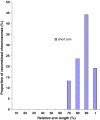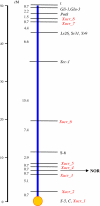Integrated genetic map and genetic analysis of a region associated with root traits on the short arm of rye chromosome 1 in bread wheat
- PMID: 19544051
- PMCID: PMC2729422
- DOI: 10.1007/s00122-009-1088-0
Integrated genetic map and genetic analysis of a region associated with root traits on the short arm of rye chromosome 1 in bread wheat
Abstract
A rye-wheat centric chromosome translocation 1RS.1BL has been widely used in wheat breeding programs around the world. Increased yield of translocation lines was probably a consequence of increased root biomass. In an effort to map loci-controlling root characteristics, homoeologous recombinants of 1RS with 1BS were used to generate a consensus genetic map comprised of 20 phenotypic and molecular markers, with an average spacing of 2.5 cM. Physically, all recombination events were located in the distal 40% of the arms. A total of 68 recombinants was used and recombination breakpoints were aligned and ordered over map intervals with all the markers, integrated together in a genetic map. This approach enabled dissection of genetic components of quantitative traits, such as root traits, present on 1S. To validate our hypothesis, phenotyping of 45-day-old wheat roots was performed in five lines including three recombinants representative of the entire short arm along with bread wheat parents 'Pavon 76' and Pavon 1RS.1BL. Individual root characteristics were ranked and the genotypic rank sums were subjected to Quade analysis to compare the overall rooting ability of the genotypes. It appears that the terminal 15% of the rye 1RS arm carries gene(s) for greater rooting ability in wheat.
Figures




Similar articles
-
Dissection of QTL effects for root traits using a chromosome arm-specific mapping population in bread wheat.Theor Appl Genet. 2011 Mar;122(4):759-69. doi: 10.1007/s00122-010-1484-5. Epub 2010 Dec 11. Theor Appl Genet. 2011. PMID: 21153397 Free PMC article.
-
Dosage effect of the short arm of chromosome 1 of rye on root morphology and anatomy in bread wheat.J Exp Bot. 2010 Jun;61(10):2623-33. doi: 10.1093/jxb/erq097. Epub 2010 May 5. J Exp Bot. 2010. PMID: 20444906 Free PMC article.
-
Linkage mapping of powdery mildew and greenbug resistance genes on recombinant 1RS from 'Amigo' and 'Kavkaz' wheat-rye translocations of chromosome 1RS.1AL.Genome. 2004 Apr;47(2):292-8. doi: 10.1139/g03-101. Genome. 2004. PMID: 15060581
-
Genetic and physical mapping of sequence-specific amplified polymorphic (SSAP) markers on the 1RS chromosome arm of rye in a wheat background.Theor Appl Genet. 2003 Nov;107(7):1271-7. doi: 10.1007/s00122-003-1367-0. Epub 2003 Aug 1. Theor Appl Genet. 2003. PMID: 12898027
-
[Molecular cytogenetic identification of a new 1RS/1BL translocation line with secalin absence].Yi Chuan. 2005 Jul;27(4):513-7. Yi Chuan. 2005. PMID: 16120568 Chinese.
Cited by
-
A Major Root Architecture QTL Responding to Water Limitation in Durum Wheat.Front Plant Sci. 2019 Apr 10;10:436. doi: 10.3389/fpls.2019.00436. eCollection 2019. Front Plant Sci. 2019. PMID: 31024600 Free PMC article.
-
Harnessing translational research in wheat for climate resilience.J Exp Bot. 2021 Jul 10;72(14):5134-5157. doi: 10.1093/jxb/erab256. J Exp Bot. 2021. PMID: 34139769 Free PMC article. Review.
-
Alien chromosome segment from Aegilops speltoides and Dasypyrum villosum increases drought tolerance in wheat via profuse and deep root system.BMC Plant Biol. 2019 Jun 7;19(1):242. doi: 10.1186/s12870-019-1833-8. BMC Plant Biol. 2019. PMID: 31174465 Free PMC article.
-
QTL for root angle and number in a population developed from bread wheats (Triticum aestivum) with contrasting adaptation to water-limited environments.Theor Appl Genet. 2013 Jun;126(6):1563-74. doi: 10.1007/s00122-013-2074-0. Epub 2013 Mar 24. Theor Appl Genet. 2013. PMID: 23525632
-
Fine mapping of the first multi-fertility-restoring gene, Rf(multi), of wheat for three Aegilops plasmons, using 1BS-1RS recombinant lines.Theor Appl Genet. 2015 Apr;128(4):723-32. doi: 10.1007/s00122-015-2467-3. Epub 2015 Feb 12. Theor Appl Genet. 2015. PMID: 25673141
References
-
- {'text': '', 'ref_index': 1, 'ids': [{'type': 'PMC', 'value': 'PMC1202783', 'is_inner': False, 'url': 'https://pmc.ncbi.nlm.nih.gov/articles/PMC1202783/'}, {'type': 'PubMed', 'value': '17246322', 'is_inner': True, 'url': 'https://pubmed.ncbi.nlm.nih.gov/17246322/'}]}
- Bernatzky R, Tanksley SD (1986) Toward a saturated linkage map in tomato based on isozymes and random cDNA sequences. Genetics 112:887–898 - PMC - PubMed
-
- Böhm W (1979) Methods of studying root systems. Ecol Stud. pp 188
-
- Braun HJ, Payne TS, Morgounov AI, Ginkel Mv, Rajaram S (1998) The challenge: one billion tons of wheat by 2020. In: Proceedings of the Ninth International Wheat Genetics Symposium, Saskatoon, Saskatchewan, Canada, 2–7 August 1998, pp 33–40
-
- {'text': '', 'ref_index': 1, 'ids': [{'type': 'DOI', 'value': '10.1007/s11032-007-9120-z', 'is_inner': False, 'url': 'https://doi.org/10.1007/s11032-007-9120-z'}]}
- Caruso M, Federici CT, Roose ML (2008) EST-SSR markers for asparagus genetic diversity evaluation and cultivar identification. Mol Breed 21:195–204
-
- {'text': '', 'ref_index': 1, 'ids': [{'type': 'DOI', 'value': '10.1007/BF00222910', 'is_inner': False, 'url': 'https://doi.org/10.1007/bf00222910'}, {'type': 'PubMed', 'value': '24173051', 'is_inner': True, 'url': 'https://pubmed.ncbi.nlm.nih.gov/24173051/'}]}
- Champoux MC, Wang G, Sarkarung S, Mackill DJ, O’Toole JC, Huang N, McCouch SR (1995) Locating genes associated with root morphology and drought avoidance in rice via linkage to molecular markers. Theor Appl Genet 90:969–981 - PubMed

